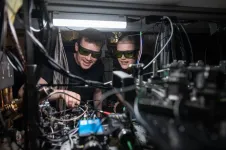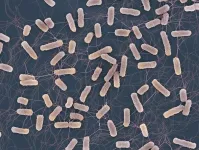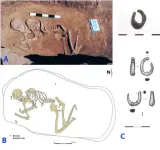(Press-News.org) NEW YORK, NY (Feb. 5, 2025)--Columbia scientists have found specialized neurons in the brains of mice that order the animals to stop eating.
Though many feeding circuits in the brain are known to play a role in monitoring food intake, the neurons in those circuits do not make the final decision to cease eating a meal.
The neurons identified by the Columbia scientists, a new element of these circuits, are located in the brainstem, the oldest part of the vertebrate brain. Their discovery could lead to new treatments for obesity.
“These neurons are unlike any other neuron involved in regulating satiation,” says Alexander Nectow, a physician-scientist at Columbia University Vagelos College of Physicians and Surgeons, who led the research with Srikanta Chowdhury, an associate research scientist in the Nectow lab.
“Other neurons in the brain are usually restricted to sensing food put into our mouth, or how food fills the gut, or the nutrition obtained from food. The neurons we found are special in that they seem to integrate all these different pieces of information and more.”
Cells found in brainstem
The decision to stop eating is a familiar phenomenon. “It happens every time we sit down to eat a meal: At a certain point while we’re eating, we start to feel full, and then we get fuller, and then we get to a point where we think, okay, that's enough,” Nectow says.
How does the brain know when the body has had enough--and how does it act on that information to stop eating?
Other researchers had previously tracked the decision-making cells to the brainstem, but the leads ended there.
Nectow and Chowdhury deployed new single-cell techniques that make it possible to peer into a region of the brain and discern different types of cells that until now have been difficult to distinguish from one another.
“This technique—spatially resolved molecular profiling—allows you to see cells where they are in the brainstem and what their molecular composition looks like,” Nectow says.
During their profiling of a brainstem region known for processing complex signals, the researchers spotted previously unrecognized cells that had similar characteristics to other neurons involved in regulating appetite. “We said, ‘Oh, this is interesting. What do these neurons do?’”
Neurons track each bite
To see how the neurons influenced eating, the researchers engineered the neurons so they could be turned on and off, by the researcher, with light.
When the neurons were activated by the light, the mice ate much smaller meals. The intensity of the activation determined how quickly animals stopped eating. “Interestingly, these neurons don’t just signal an immediate stop; they help the mice to slow down their eating gradually,” Chowdhury says.
Nectow and Chowdhury also looked at how other eating circuits and hormones affected the neurons. The researchers found that the neurons were silenced by a hormone that increases appetite and activated by a GLP-1 agonist, a class of drugs now popular for treating obesity and diabetes. These experiments found that these inputs helped the neurons track each bite the mice took.
“Essentially these neurons can smell food, see food, feel food in the mouth and in the gut, and interpret all the gut hormones that are released in response to eating,” Nectow says. “And ultimately, they leverage all of this information to decide when enough is enough.”
Though the specialized neurons were found in mice, Nectow says their location in the brainstem, a part of the brain that is essentially the same in all vertebrates, suggests that it is highly likely that humans have the same neurons.
“We think it's a major new entry point to understanding what it means to be full, how that comes about, and how that is leveraged to end a meal,” Nectow adds. “And we hope that it could be used for obesity therapies down the road.”
More information
The findings appear in a paper, “Brainstem Neuropeptidergic Neurons Link a Neurohumoral Axis to Satiation,” published Feb. 5 in Cell.
All authors (from Columbia University unless noted): Srikanta Chowdhury, Nachiket G. Kamatkar, Wendy Xueyi Wang (Broad Institute, Massachusetts Institute of Technology, and Harvard University), Christa A. Akerele, Jiahao Huang (Broad Institute and MIT), Junlin Wu, Amajindi Nwankpa, Charlotte M. Kane, Varun M. Bhave, Hao Huang (Princeton University), Xiao Wang (Broad Institute and MIT), and Alexander R. Nectow.
The research was supported by a Russell Berrie Foundation Fellowship, the American Diabetes Association, Damon Runyon Cancer Research Foundation’s Damon Runyon-National Mah Jongg League, Inc. Fellowship, the Searle Scholars Program, Thomas D. and Virginia W. Cabot and Edward Scolnick Professorships, Ono Pharma Breakthrough Science Initiative Award, a Merkin Institute Fellowship, an NIH New Innovator Award, New York Nutrition and Obesity Research Center, and the Berrie Program in the Neurobiology of Body Weight Regulation.
###
Columbia University Irving Medical Center (CUIMC) is a clinical, research, and educational campus located in New York City. Founded in 1928, CUIMC was one of the first academic medical centers established in the United States of America. CUIMC is home to four professional colleges and schools that provide global leadership in scientific research, health and medical education, and patient care including the Vagelos College of Physicians and Surgeons, the Mailman School of Public Health, the College of Dental Medicine, the School of Nursing. For more information, please visit cuimc.columbia.edu.
END
Researchers discover the brain cells that tell you to stop eating
2025-02-05
ELSE PRESS RELEASES FROM THIS DATE:
Salt substitution and recurrent stroke and death
2025-02-05
About The Study: The results of this cluster trial demonstrate that salt substitution was safe, along with reduced risks of stroke recurrence and death, which underscores large health gains from scaling up this low-cost intervention among patients with stroke.
Corresponding Authors: To contact the corresponding authors, email Lijing L. Yan, MPH, PhD, (lijing.yan@duke.edu) and Maoyi Tian, PhD, (maoyi.tian@hrbmu.edu.cn)
To access the embargoed study: Visit our For The Media website at this link https://media.jamanetwork.com/
(doi:10.1001/jamacardio.2024.5417)
Editor’s Note: Please see the article for additional information, ...
Firearm type and number of people killed in publicly targeted fatal mass shooting events
2025-02-05
About The Study: This study found that most publicly targeted fatal mass shootings involved multiple types of firearms and handguns were the most common type of firearm present. Assault weapons being present during a publicly targeted mass shooting was associated with a slight increase in the number of injuries and deaths occurring during that incident.
Corresponding Author: To contact the corresponding author, Leslie M. Barnard, MPH, DrPH, email leslie.barnard@ucdenver.edu.
To access the embargoed study: Visit our For The Media website at this link https://media.jamanetwork.com/
(doi:10.1001/jamanetworkopen.2024.58085)
Editor’s ...
Recent drug overdose mortality decline compared with pre–COVID-19 trend
2025-02-05
About The Study: Drug overdose deaths have increased exponentially since 1979. This rate of increase accelerated during the COVID-19 pandemic but has since waned. When comparing recent drug-related mortality rates with their pre-2020 trajectory, the vast majority of states remained higher than expected. In the 4 years between 2020 and 2023, nearly all states had higher drug-related mortality rates than their 2019 rates.
Corresponding Author: To contact the corresponding author, Keith Humphreys, ...
University of Cincinnati experts present research at International Stroke Conference 2025
2025-02-05
University of Cincinnati experts will present research at the International Stroke Conference 2025 in Los Angeles.
Study finds small number of patients eligible for new ICH treatment
Intracerebral hemorrhage (ICH), when there is bleeding into brain tissue from the rupture of a damaged blood vessel, is one of the most devastating types of stroke. Patients often suffer from severe neurologic disability or even death. There were no proven treatments for patients with ICH until recently.
“We now have one ...
Physicists measure a key aspect of superconductivity in “magic-angle” graphene
2025-02-05
Superconducting materials are similar to the carpool lane in a congested interstate. Like commuters who ride together, electrons that pair up can bypass the regular traffic, moving through the material with zero friction.
But just as with carpools, how easily electron pairs can flow depends on a number of conditions, including the density of pairs that are moving through the material. This “superfluid stiffness,” or the ease with which a current of electron pairs can flow, is a key measure of a material’s superconductivity.
Physicists at MIT and Harvard University have now directly measured superfluid stiffness for the first time ...
Study in India shows kids use different math skills at work vs. school
2025-02-05
In India, many kids who work in retail markets have good math skills: They can quickly perform a range of calculations to complete transactions. But as a new study shows, these kids often perform much worse on the same kinds of problems as they are taught in the classroom. This happens even though many of these students still attend school or attended school through 7th or 8th grades.
Conversely, the study also finds, Indian students who are still enrolled in school and don’t have jobs do better on school-type math problems, but they often fare poorly at the kinds of problems that occur in marketplaces.
Overall, both the “market kids” and the “school kids” ...
Quantum algorithm distributed across multiple processors for the first time – paving the way to quantum supercomputers
2025-02-05
UNDER EMBARGO UNTIL 16:00 GMT / 11:00 ET WEDNESDAY 5 FEBRUARY 2025
Quantum algorithm distributed across multiple processors for the first time – paving the way to quantum supercomputers
In a milestone that brings quantum computing tangibly closer to large-scale practical use, scientists at Oxford University Physics have demonstrated the first instance of distributed quantum computing. Using a photonic network interface, they successfully linked two separate quantum processors to form a single, fully connected ...
Why antibiotics can fail even against non-resistant bacteria
2025-02-05
Antibiotics are indispensable for treating bacterial infections. But why are they sometimes ineffective, even when the bacteria are not resistant? In their latest study published in the journal Nature, researchers from the University of Basel challenge the conventional view that a small subset of particularly resilient bacteria are responsible for the failure of antibiotic therapies.
In certain infectious diseases caused by bacteria, antibiotics are less effective than expected. One example is infections caused by Salmonella bacteria, which can lead to illnesses such ...
Missing link in Indo-European languages' history found
2025-02-05
Where lies the origin of the Indo-European language family? Ron Pinhasi and his team in the Department of Evolutionary Anthropology at the University of Vienna contribute a new piece to this puzzle in collaboration with David Reich's ancient DNA laboratory at Harvard University. They analyzed ancient DNA from 435 individuals from archaeological sites across Eurasia between 6.400–2.000 BCE. They found out that a newly recognized Caucasus-Lower Volga population can be connected to all Indo-European-speaking populations. The new ...
Cancer vaccine shows promise for patients with stage III and IV kidney cancer
2025-02-05
Boston – Dana-Farber Cancer Institute researchers report that all nine patients in a clinical trial being treated for stage III or IV clear cell renal cell carcinoma (a form of kidney cancer), generated a successful anti-cancer immune response after initiation of a personalized cancer vaccine. The vaccines were administered after surgery to remove the tumor and are designed to train the body’s immune system to recognize and eliminate any remaining tumor cells. At the time of data cut-off (median of 34.7 months), ...



